This drop down section is a miscellaneous potpourris of general background info that is relevant to this site and may be of interest to some viewers.
IMAGES…………………………………………………………………………………
Here you will find various images, diagrams, maps and still photos of possible interest but that are not necessarily appropriate or otherwise don’t fit into the various documents and text narratives addressed on this site. The collage below is intended to be indicative of the types of such images, however generally I will provide an explanatory caption or narrative (plus my reason(s) for including it).
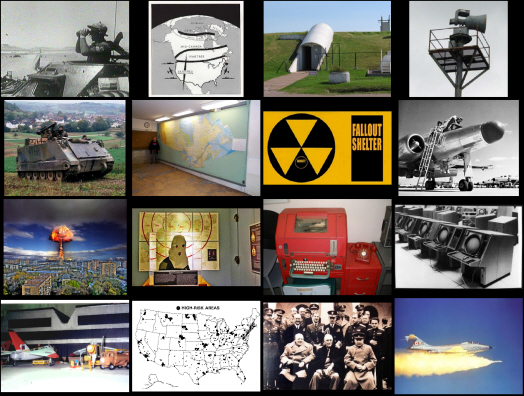
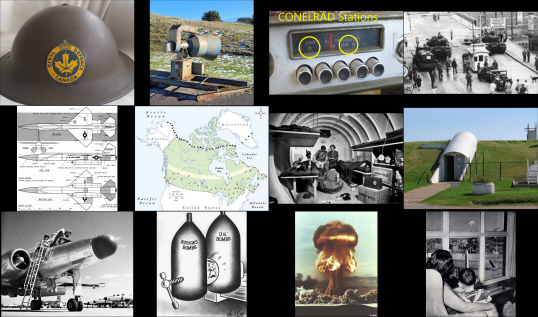
VIDEOS………………………………………………………………………
This part of the website contains references to relevant videos and how to access them. One excellent source of such videos is the Prelinger Archives which is a US site) that contains an eclectic collection of such material. Another is the Canadian Broadcasting Corporation’s archives. Additionally there are other sources of individual videos, the access to which is described particular to its source.
This You Tube video “The Cold War” sort of (in less than three minutes) encapsulates the war from the early 1940’s to the fall of the Berlin Wall in 1989.
YouTube Video – For a taste of an incident illustrating how close we came to nuclear war please check out this video ‘This War Game Glitch Almost Ended the World’ submitted by a former Diefenbunker Museum volunteer. (There will be ads). Some of the comments are worth a read as well. There were many incidents like this during the Cold War.
Prelinger Archives Civil Defense and other Cold War (including propaganda) films (such as the following 1955 US Government Film “About Fallout” https://archive.org/details/AboutFal1955 can be viewed and in most cases downloaded for free. For a taste of one incident
Here is a recently discovered (by me anyway) 2004 video “Inside the Diefenbunker” showing the bunker as it was in 2004, about seven years after it was acquired by volunteers who where then in the process of attempting to create a Real Canadian Cold War Museum. It was created by the late James Hendricks who was an independent journalist and produce in Toronto. It features Shawna Moffett (then the full-time manager of the Museum) and Doug Beaton who along with his wife Louise Fox were retired Parks Canada Conservators and for two decades huge contributors to the development of the museum.
The Canadian Civil Defence Museum has an extensive collection of links to a wide variety of Cold War Videos. Worth perusing.
MUSIC…………………………………………………………………………………..
‘Battle of the Bands’ – This is a collection of military, nationalist and generally ‘inspiring’ and ‘patriotic’ music from the Cold War (friends and foes alike). Early on in the 2000s , while surfing the internet I came across a wonderful website with a vast collection of Soviet/Russian military and nationalist music with a capability to be downloaded. It is dramatic, exciting stuff and inspired me to search for more such music from other nations. I have assembled what I think is a representative collection of various pieces from both sides of the ‘Iron Curtain. Some years ago I was intending this collection be assenmbled on a CD and possibly sold in the bunker’s gift shop (after sorting out copyright issues of course). Unfortunately (from a fundraising POV it never happened (probably too militaristic for the staff). In any case I believe that the selections that follow are in the public domain, but if anyone has any problems with that let me know and I will immediately remove the piece in question.
“Preobrajensky March” from Our Response to NATO (1999) by Brass Band of the USSR Ministry of Defence, N. Nazarov, cond.. Track 3. – defiant, proud, in-your-face-NATO, arrogant but very rousing! And typically very (chip-on-the-shoulder) Russian.
United Kingdom/ British Army -“The British Grenadiers” The British ‘equivalent’ of the above but “The Empire” era.
The “Internationale” by Billy Bragg- the marching song of the international socialist/communist movement. Listen carefully to the words…very emotional!
United States of America – “The Stars and Stripes Forever” See USSR, the UK above and “La France” below.
La France –“La Marseillaise” – Mireille Mathieu …Even not understanding all of the words this brings tears to ones eyes! I can’t resist adding this link to a French “New Version” video. But in my opinion Mireille’s is the best!
Federal Republic of Germany “Panzerlied”
Cossack Patrol – “Calvary of the Steppes”
“Killaloe” A Regimental March of the British Army
“O-Canada” National Anthem of Canada
USA – “King Cotton”
“Aces-High” Federal republic of Germany Luftwaffe March
La france “Les Huguenotes”
USA – “National Emblem”
UK – “Trumpet Prelude”
To get the full patriotic “Mother Russia” (or should I say “Soviet” experience you can link to this “10 hours of Soviet Communist Music” YouTube video.
“THE STAR TOOLS“

The Star Tools were a rock and roll band of mostly medical doctors (including one of the Bunker’s founders, Dr. Barry Bruce) who helped charitable organizations raise money for fundraising events in Ottawa and surrounding areas, including the Diefenbunker Museum. One of their projects was to produce a CD of songs from the Cold War era called Blastorama. It was recorded in the Diefenbunker’s original CBC Studio. Jim Morrison the CBC technician who originally installed the CBC studio equipment in the early 1960s (and later reinstalled it again in 1999 when the bunker was on its way to becoming a museum) was the recording technician for the Star Tools CD.

This link (BLASTORAMA) connects with a sample of the Star Tools repertoire from a concert they gave to the NAPCRG- North American Primary Care Research Group at an online meeting November 2022. Dr. Bruce re-wrote the words to Good Lovin’ to reflect a Covid theme – seems appropriate!
The Atomic Platters
A 5CD/1DVD-Box & 292-Page-Book available on Amazon for about US$ 270.

Bear Family Box
Format: 5-CD/1-DVD-Box (LP-Format) with 292 page book
Genre: Musik- & Zeitgeschichte
ArtNr: BCD 16065 FM
For the two years the staff of CONELRAD has been engaged in a top secret project, a kind of “musical Manhattan Project,” if you will. Not unlike the real Manhattan Project, our labour has resulted in a product that is extremely radioactive. Culturally radioactive, that is.
With this clandestine work finally concluded, we are extremely proud to formally announce that ATOMIC PLATTERS: COLD WAR MUSIC FROM THE GOLDEN AGE OF HOMELAND SECURITY, a five CD/1 DVD box set capturing the best in vintage atomic music and film…
To ensure that this collection is definitive in every sense of the word, CONELRAD has worked hand-in-hard with the prestigious Bear Family Records of Germany to produce a set that should have fans of this genre salivating. Just look at what you’ll find on ATOMIC PLATTERS:
- Over 100 Cold War tracks featuring CONELRAD favorites Slim Gaillard, Janet Greene, The Goldwaters, Bill Haley, Ann-Marget, Carl Perkins, Carl Mann and many, many more!
- Two full-length spoken word ‘scare’ albums from 1961 re-issued for the first time: IF THE BOMB FALLS and THE COMPLACENT AMERICANS!
- More than two dozen frighteningly naïve Public Service Announcements, many voiced by such celebrities as Groucho Marx, Pat Boone and Johnny Cash!
- A DVD with nine short-subject civil defense and anti-Communist films!
- A nearly 300 page hardbound book bursting with Cold War era photos and bizarre art with liner notes by CONELRAD co-founder Bill Geerhart!
Please see the Atomic Platters link above for the full Amazon description of the contents of these six CDs (looks like the are getting very rare).
LINKS…………………………………………………………………………………..
Early Diefenbunker CCW MuseumWeb Site
Attempts were made early on as we were setting up the Museum to create a Diefenbunker website with appropriate Cold War Canada related information. For a while in those early days as a Museum we had the elements of such a site. See the Internet Archives Wayback Machine ‘capture’ link below for an example page (2005) of the then nascent website. https://web.archive.org/web/20040804005319/http://www.diefenbunker.ca:80/english/docs/0/9.asp?id=9&tpe=Web Click on Home to get the general site (be aware that some of the associated links may not be active…it’s old stuff!)
Other Cold War Museums and Related Sites
Besides the Diefenbunker, Canada’s Cold War Museum located in Carp, Ontario, readers should also be aware of other efforts to remember and commemorate Canadian civil preparedness activities during the Cold War. They all need our moral (and financial) support to continue. Those that I have come across so far include:
The Canadian Civil Defence Museum Edmonton based at the former AlSask air defence radar site (virtually on the Alberta / Saskatchewan border). Besides having the AlSask physical location to collect and display relevant Cold War artifacts and archives, their website is crammed with all kinds of links, photos, videos and text mainly centered around Canadian Civil Defence during the Cold War “Preserving, protecting, and presenting the Canadian Civil Defence emergency preparedness history”. Fred Armbruster is the founder and Executive Director. Given his limited resources (especially financial) I believe he has done (and continues to do) a very good job in putting this together. I would like to especially recommend visiting their cold war YOUTUBE videos page with its extensive collections of relevant videos and slideshows. Also they have a very good “Canadian and USA Links Section”
The Debert, Nova Scotia ‘Diefenbunker’ (formerly the Continuity of Government’s NS Regional Emergency Government HQ ‘bunker). I wasn’t able to find a Google web page for this museum (it does have something on Facebook – I don’t do Facebook – but you can use the above Google urls to search for further information). I have been trying to contact the owner without any luck. Myself and a DCCWM member did visit this location many years ago. It has a lot of potential and is definitely worth a visit.
‘Secrets’ of the Diefenbunker
What are the Secrets of the Diefenbunker ? Take a look at this podcast link to Episode #70 (2018) one of an extensive series of history-oriented pieces actualized by Mr Sebastian Major, a professional history pod-caster. Sebastian is the creator and host of the podcast series Our Fake History (but as he says this one isn’t fake! (He produces them in Toronto. ON with the help of his wife, Beth).
To quote Sebastian: “In a small town outside of Canada’s capital city of Ottawa there sits a remarkable relic of the atomic age. It is a massive bunker that would have become the headquarters of the Canadian government if the country was the target of a nuclear attack. It has been dubbed “The Diefenbunker” in honour of John Diefenbaker, the Prime Minister who had the facility constructed in 1959. The bunker is now celebrating 20 years as Canada’s Cold War museum. Join Sebastian as he is lead through this incredible feat of engineering by one of the museum’s curators. This is an episode that is less about busting historical myths and is more about exploring an artifact that challenges us to re-think Canada’s Cold War legacy. Tune in and find out how refrigerator morgues, Scrooge McDuck, and the Prime Minister’s sad little bed all play a role in the story.”
The Canadian Arctic Early Warning Radar Dew Line
Dew Line Adventures (Adventures from the Coldest Part of the Cold War) This is the true story of one person’s involvement in a very small part of what was known as the Cold War. That small part was about a group of people who watched over the North American continent from radar sites in the far north.
The Civil Defence League of Canada
“The Civil Defence League of Canada is a non-governmental civil defence initiative promoting citizen-centric civil defence in a world where major nuclear warfare is again a credible threat. We encourage broad public education in personal safety know-how for nuclear attack scenarios. We advocate for community fallout shelter programs as well as general preparedness for other types of disasters and emergencies. And we maintain it is vital to protect our electrical grid from a nuclear or natural EMP which, according to official estimates, could in effect take down our civilization for a year or more, resulting in the deaths of up to 90 percent of the North American population. Above all else, we work to revive nuclear civil defence preparedness on the part of officials, emergency responders and everyday Canadians – measures that could save millions of lives in the event of a nuclear attack on North America”. They have a lot of information about personal and family protection in the event of a nuclear attack. This video (taken from an 1963 film entitled Protection Faction 100 is an example. They also offer free courses in related topics.

The (Online) United States Civil Defense Museum
Civil Defense Museum “This US virtual/online museum is dedicated to the Civil Defense and emergency workers of the United States who worked to protect the public from nuclear attack. Thankfully, their services, in that aspect, were never needed. This virtual museum is for historical purposes and does not make fun of civil defense, however, I do throw in a few “light” comments here and there. There are many aspects of the Civil Defense program that may seem funny today, but the period after World War II was a very scary time. Civil defense officials and volunteers during that time were very serious about their work and I believe they deserve respect for their efforts. They rendered emergency services after natural and man-made disasters and would have had an impossible task had there ever been a nuclear war.” A good source of online information including about sirens, art, history, supplies, etc. AND it has some Canadian stuff on it including about out CLM sirens….click HERE to HEAR!
The (Physical) United States Civil Defense Museum, Vint Hill, Virginia
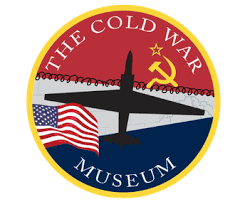
The following is an edited quote from the ‘About Us” section of their website. In the early 2000s I corresponded with (and later met Francis Gary Powers Jr. at an international seminar of Nuclear War Facilities operators. It was sponsored by and held in the Diefenbunker CCWM. At that time Mr. Powers was in the process of trying to find and acquire a suitable physical facility as a place to display the vast collection of Cold War artifacts that he had assembled over the years. The Museum notes a pdf entitled “The Cold War Museum “See why we built the Cold War Museum” which is an excellent slide presentation explaining their founding and objectives. Here is a link to their recent newsletter with an article which is quite pertinent to the present world situation.
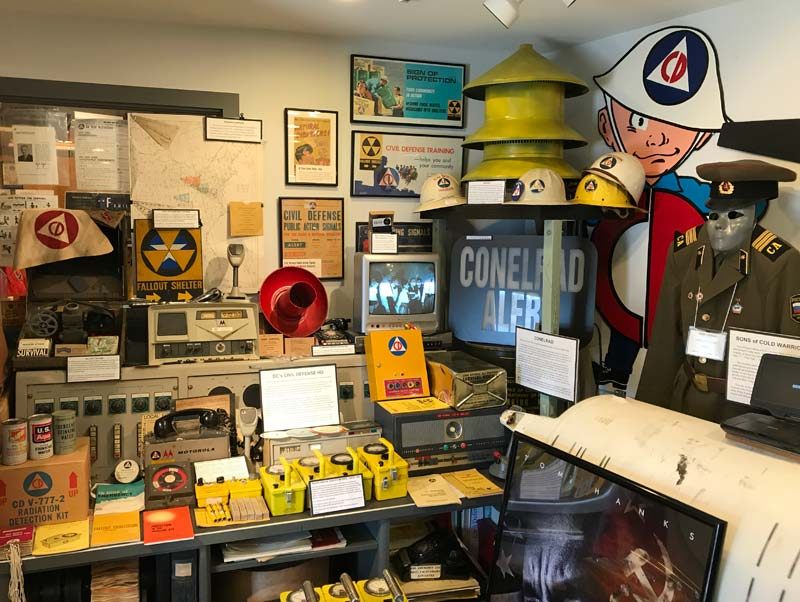
“The Cold War Museum was founded in 1996 by Francis Gary Powers Jr., son of the famed U-2 Pilot, and John Welch to preserve Cold War history, honor Cold War veterans, and educate future generations about the Cold War and its legacy. Since 2011, the Museum has been located at Vint Hill, Virginia, on the grounds of the former Vint Hill Farms Station, also known as Monitoring Station No. 1, which was a Top Secret Army signals intelligence base during WWII and the Cold War. Our collections are particularly strong in signals intelligence (SIGINT), image intelligence (IMINT), the history of Vint Hill during both WWII and the Cold War, Cold War Berlin, Civil Defense, atomic weapons, the Liberty and Pueblo incidents, Cold War cultural and Olympic competitions, Strategic Air Command, submarine detection (SOSUS), the Cuban Missile Crisis, the STASI (East German secret police), and Soviet and East German disinformation campaigns. Many of our artifacts are rare and some are one-of-a-kind, and some of our exhibits were created and donated by those who did the work. The Cold War Museum is an all-volunteer organization, drawing upon our staff’s extensive Cold War experience as professionals in the military and intelligence communities.
Oak Ridge Associated Universities
This US Oak Ridge Associated Universities (ORAU) site is entitled the Health Physic Historical Instrumentation Section Museum Directory of the ORAU. It has a large collection of information on this subject and many interesting related topics. Very pictorial and cross-related information. Click on above link to view the main site with its dozens of additional links to various topics and from there to sub-links to much, much more information. A specific example of the detail provided is US Civil Defense Signage,
“Oak Ridge Associated Universities (ORAU) provides innovative scientific and technical solutions to advance national priorities in science, education, security and health. Through specialized teams of experts, unique laboratory capabilities and access to a consortium of more than 100 major Ph.D.-granting institutions, ORAU works with federal, state, local and commercial customers to advance national priorities and serve the public interest.”
Richard Brisson’s “CampX” Website on Spys and Cryptology
Richard’s website is “… intended to reflect a portion of my personal collection of items/artifacts which relate to cryptology, vintage clandestine or espionage tradecraft, and communications technology particularly equipment used by the major powers during the Cold War and by the Canadian military during WW-II. This collection has been accumulated over the last 20 years or so. You will also notice an emphasis on vintage children’s decoders and spy toys over the years starting with the decoder badges and instruction manuals associated with Radio Orphan Annie and Captain Midnight starting in the 1930’s with radio reception become popular especially in American homes. Another partnership ensued with the Diefenbunker in Carp (near Ottawa, Ontario) to launch a “Spy Tools” exhibit. The Diefenbunker is also known as Canada’s Cold War Museum. The exhibit was in place from February 2002 until early September 2002. The display was expanded to a 2-room display to accommodate children’s clandestine toys over the years – that included items such as Secret Sam, Batman cards, James Bond, Spiderman and Get Smart. A local television station CJOH aired a short piece related to this Diefenbunker exhibit and this collection on 27 April 2002 during “Regional Contact”.
Simple Shelters by Andrew Burtch
Monitoring Radioactive Fallout Across Canada, 1959-63
Abstract: During the early Cold War, the Canadian government advised the public that they could cheaply build fallout shelters in their homes to protect their families from radiation after a nuclear war. Publicly, the government stayed out of the shelter-building business, citing that the cost was too high. However, from 1959 to the mid-1960s, the Canadian Army secretly constructed a network of 2,000 fallout shelters in government buildings: the Nuclear Detonation and Fallout Reporting System. This article explores the origins of this network and the reasons for its decline.
YouTube Video of a Titan II Launch Crew Procedure Re-Enacted (for touring visitors) at the Titan II Museum Just south of Tucson, AZ
YouTube Video of a USAF ICBM Launch (GULP!)
Books…………………………………………………………………………………….
The Canadian War Museum has an extensive collection (I don’t know how many) of Cold War Books and documents which can be accessed through their website, particularly using their on-line listing at https://cmhcwm-mchmcg.on.worldcat.org/search?queryString=cold%20war&clusterResults=false&groupVariantRecords=true
https://cmhcwm-mchmcg.on.worldcat.org/search?queryString=cold%20war&clusterResults=false&groupVariantRecords=true&page=1t
Note: The Diefenbunker, Canada’s Cold War Museum also has an extensive library (primarily created, curated, organised and maintained by Doug Beaton*, former Parks Canada conservator and long-time volunteer at the Museum, mostly using his own time and funds). This research library currently has over 6000 books.
Andrew Burtch – War Museum historian’s tale of the Cold War in Canada October 28, 2014
(Those interested in a REVIEW of this book should link to http://www.journal.forces.gc.ca/vol13/no2/page89-en.asp)
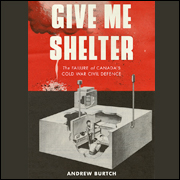
People called it the Cold War, the era when the world seemed to teeter on the edge of an atomic Armageddon. It was a harrowing time of home fallout shelters and public service announcements telling frightened citizens to “duck and cover” in the event of a nuclear holocaust.
Faced with potential annihilation, ordinary Canadians reacted with general indifference, while there was confusion regarding jurisdiction among the various levels of government.
Give Me Shelter: The Failure of Canada’s Cold War Civil Defence (UBC Press, 2012) by Canadian War Museum historian Andrew Burtch, winner of this year’s C.P. Stacey Award for most distinguished book on Canadian military history, tells the story of Canada’s half-hearted, haphazard attempts to deal with the threat of nuclear war in the two decades following the end of the Second World War.
In Canada, serious planning began in the late 1940s. “All across the Western alliance,” says Burtch, the Museum’s historian for the post-1945 period, “it seemed reasonable that governments should have some kind of program in the advent of nuclear attack.” But the specifics of the program changed as nuclear weapons evolved. The initial model, he says, “was the London Blitz applied to the nuclear age” — individuals were trained as firefighters, air-raid wardens and nurses on the assumption that enough people would survive the initial attack and could then help the wounded and fight the fires. By the early 1950s, however, with the development of more powerful bombs — the “city killers” — the emphasis was on evacuation. And the advent of intercontinental ballistic missiles in the late 1950s called for a “stay put approach. You built a shelter to put some protection between your family and atomic fallout.”
The entire civil defence program, says Burtch, was “dogged by apathy. In the dark days of the Korean War or the Cuban missile crisis, tension was high” and so was speculation. But unless confronted by crisis, people showed no concern. “Once the emergency passed, and things looked like they were under control, their interest faded almost immediately.” When an ambitious evacuation exercise in Calgary had to be cancelled because of a heavy snowfall, “the mayor said if the weather had been that bad the Soviets wouldn’t have attacked anyway.” Differing levels of government squabbled over who should pay for civil defence or whether to be involved at all. “British Columbia and Alberta were really up on it in the 1950s. Ontario and Quebec were not, and refused all funding.”
Responsibility for civil defence was kicked from ministry to ministry. After 1968, the Cold War rhetoric began to cool, the sense of urgency faded altogether and civil defence was forgotten. But, says Burtch, it never entirely disappeared. “Public Safety Canada,” the government ministry in charge of protecting the safety of Canadians today, “is in one way a direct offshoot of it.”
The C.P. Stacey Award is presented by the Canadian Committee for the History of the Second World War and the Canadian Commission for Military History. It recognizes the year’s most distinguished publication on the 20th-century military experience. In winning this prize, Burtch joins a number of current and previous colleagues at the War Museum. “Tim Cook, Dean Oliver, Jack Granatstein . . . I feel like I’m carrying on a bit of a tradition,” he says.
How the Cold War Began by Amy W. Knight

How the Cold War Began draws on newly declassified intelligence files to examine one of the twentieth century’s most influential spy cases as well as its role in generating the Cold War, discussing the defection of a cipher clerk who revealed a Soviet espionage network in North America less than a month after the atomic bombing of Japan. Amy’s website is worth perusing.
Finding Diefenbunker: Canadian Nationalism and Cold War Memory
….by Sara Maththews, Justin Anstett & Patricia Molloy (Contributor).

The text discusses the legacy of the Cold War in Canada by looking at Prime Minister Diefenbaker’s “Diefenbunkers”—eleven nuclear fallout shelters constructed in secret in the late 1950s to protect the Canadian national and provincial governments from a nuclear strike. While many of these sites have fallen into disrepair or been sold off, one such site has recently been repurposed as “Canada’s Cold War Museum” with the explicit purpose of fostering “interest and critical understanding of the Cold War.”
The text questions how the site, its museumological apparatus, and the community curation of various rooms in the museum, constructs a “Cold War” for use in Canadian memory; questions the validity of considering the Diefenbunker as a memory site, following Pierre Nora’s seminal concept; and explores the role of fictions in the interactive exhibits that aim to engage Canadian youth—in particular—in the issues of nuclear war, emergency measures, and the role of civil defence. The museum and its displays are interrogated for their performance of and possibilities for inscription, re-inscription, and resignification of Canadian cultural memory.
Life After Doomsday by Bruce Clayton
A Survivalists Guide to Nuclear War and Other Major Disasters
Dave Peters’ Note: Whether you agree with the author or not, this is an illuminating read for the basic information it contains about the effects of nuclear weapons and what can be done to attempt to survive in the aftermath of a nuclear war.
Excerpt: “There is no need to lie to people about the effects of a nuclear war. The truth is bad enough. The damage done by making the threat seem worse than it really is cannot be easily dispelled. The exaggerated tales of total annihilation convince people that survival is impossible. This is not true. For most Americans, survival of at least the first few weeks following a nuclear attack is not only possible, it is almost unavoidable. With careful preparation, any family or small group of people can insure its own survival under such conditions and also through the long period of recovery to follow.”
Paul Ozorak ‘Bunkers, Bunkers Everywhere….’
Paul Ozorak has written many books on the general theme of underground bunkers both in Canada and elsewhere in the world, as well as about lessor known military facilities. He was at one time a contributor to the Diefenbunker’s exhibits. He currently lives in the Ottawa area. Some covers of his books are displayed below. Many of them are available through Amazon.


Recommendations by Doug Beaton*
For really specific cold war Canada books:
–Cold War Canada: the Making of a National Insecurity State, 1945-1957, by Reg Whitaker and Gary Marcuse, University of Toronto Press, 1994, 0-8020-5935-X
-Misguided Missiles, Canada, the Cruise and Star Wars by Simon Rosenblum, James Lorimer and Company, 1985, 0-88862-698-3
–Canada and the Cold War by Reg Whitaker and Steve Hewitt, Lorimer, 2003, 978-1550-28769-1
